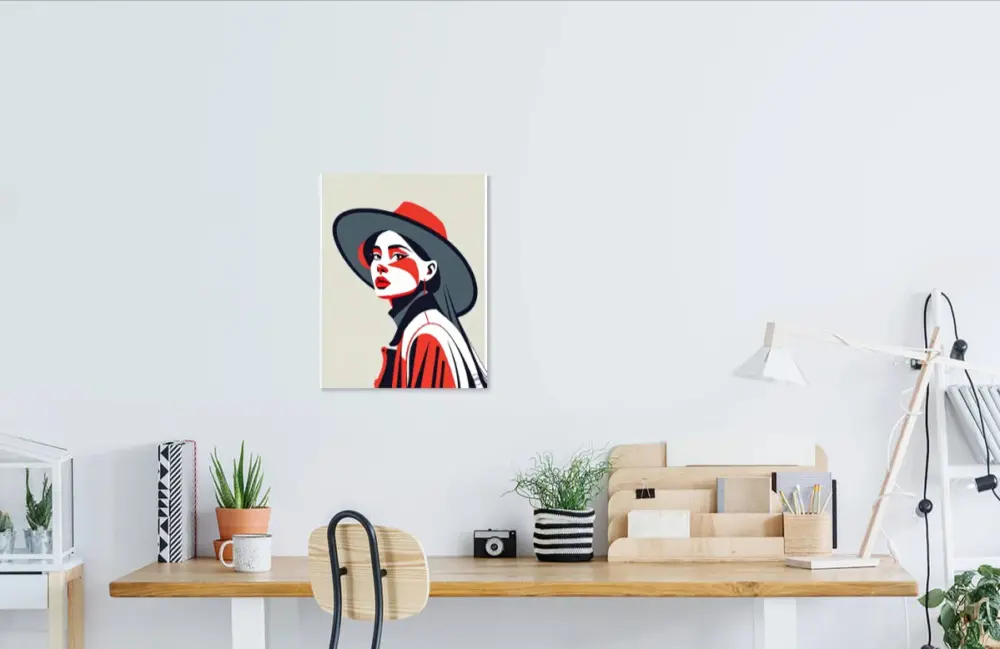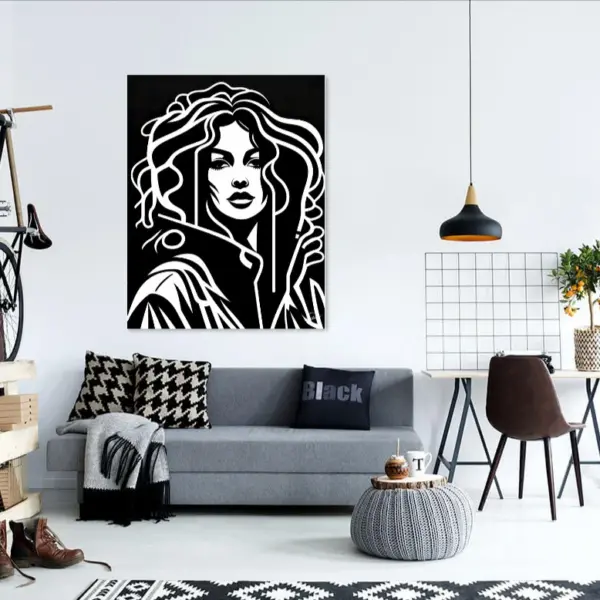Red Hat
At first glance, the artwork seems to suggest a modern fashion illustration, but it’s more than just a depiction of style. The way the woman is rendered—her sharp angles, the clean lines of her clothing, the geometric precision of her face—brings a sense of purpose to her gaze. There’s nothing accidental here. Her strong, arched eyebrows and piercing eyes, partially framed by a slash of red across her cheek, tell us she is aware of her surroundings, though her glance is directed away from us. There is a quiet power in her stance, a refusal to engage with the viewer directly, as if she holds something back, protecting herself from being fully known or understood.
The palette is dominated by a triad of colors: red, black, and white. Each shade is used with precision, creating a stark yet harmonious interplay of shapes that form the woman’s face and body. The red isn’t just on her hat—it slices across her cheek in a bold patch, outlines her lips, and wraps around her shoulders, tracing the contours of her clothing. This use of red feels symbolic, perhaps representing strength, passion, or a sense of identity that she wears like armor. Yet, even with its boldness, the red is controlled. It does not overwhelm the piece, but instead works with the black and white to create a sense of balance, of someone who has mastered the art of holding back while still commanding attention.
Her clothing, while minimal in detail, suggests sophistication. The lines of her coat, the fold of the fabric, and the buttons all speak to a refined, almost timeless style. Yet, the lack of texture or shading creates a distance—there’s no softness to be found here. Instead, there’s a cold precision that echoes through the flat planes of the composition. Her garments are drawn with the same sharpness as her expression, giving her an air of impenetrability. She’s stylish, but in a way that feels deliberate, almost armor-like, as though her appearance is both a reflection of who she is and a shield she uses to protect herself.
The hat itself—this iconic red accessory—is more than a mere piece of fashion. It is symbolic of the character she embodies. Red, throughout art history, has been a color loaded with meaning. It is the color of fire and blood, of danger and desire. Here, it suggests that beneath her cool, composed exterior, there is an inner flame, a hidden intensity that perhaps only surfaces in glimpses, like the red markings on her face. It’s a controlled flame, not wild or chaotic, but one that fuels her sense of self and purpose. The hat becomes a crown, a bold declaration of her individuality.
What’s fascinating about “Red Hat” is how the simplicity of the form contrasts with the depth of emotion and narrative the image suggests. There is so little extraneous detail, and yet every element feels purposeful, considered. The flat planes of color and the almost graphic quality of the lines give the piece a sense of timelessness, making it difficult to place the figure in a specific time or context. She could belong to any era, any place. The ambiguity of her expression and the lack of environmental context draw the viewer into a narrative that is entirely open to interpretation. Is she looking back at something or someone? Or is she deliberately turning away? The lack of clear answers invites the viewer to project their own interpretations, their own stories, onto her.
One could interpret this piece as a reflection on self-awareness and control. The woman’s posture, the subtle tilt of her head, and her outward glance all suggest someone who is conscious of being watched but is not particularly concerned with the opinions of others. There’s a confidence in her detachment, an attitude that says she does not seek approval or validation. She exists in her own world, governed by her own rules, and the viewer is only allowed to observe her from a distance.
In terms of artistic style, the piece feels modern, but it also echoes elements of classical portraiture. The focus on the subject’s face and upper body, the careful composition of light and shadow, and the use of bold, flat colors recall the works of pop art, while the subject’s confident, enigmatic demeanor brings to mind the elegance of fashion icons and muses throughout art history. This blend of influences gives “Red Hat” a certain timelessness, a sense that while the medium may be contemporary, the emotions and themes it explores are universal.
The beauty of “Red Hat” lies in its ambiguity. The woman, with her guarded expression and striking appearance, invites the viewer to wonder who she is, what she thinks, and what lies behind her carefully composed exterior. Yet, she never fully reveals herself. The artwork maintains a delicate balance between accessibility and mystery, inviting us into her world but keeping us at arm’s length. It’s a piece that speaks to the complexities of identity, the ways in which we present ourselves to the world, and the layers of meaning that can be hidden beneath the surface of even the simplest of images.
In the end, “Red Hat” is not just a portrait of a woman in stylish attire. It’s a meditation on the power of perception, on how we choose to be seen versus who we truly are. The woman, with her bold red hat and defiant glance, is both an enigma and an icon—a figure who embodies the tension between self-expression and self-preservation. And in that tension, the artwork finds its strength.






 70-140cm (27.5″≈55″) Printable
70-140cm (27.5″≈55″) Printable


